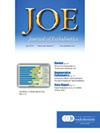Impact of Multispecies Biofilm on the Chemical and Mechanical Characteristics of Radicular Dentin from Patients With and Without Diabetes: An In Vitro Study
IF 3.6
2区 医学
Q1 DENTISTRY, ORAL SURGERY & MEDICINE
引用次数: 0
Abstract
Introduction
This in vitro study examined the effect of a multispecies biofilm on the chemical characteristics and mechanical properties of root dentin from patients with or without type 2 diabetes mellitus (DM).
Methods
Intact mandibular molars were obtained from diabetic and nondiabetic donors. Rectangular root dentin beams were prepared and categorized based on age (40–60 and 61–80 years), presence/absence of DM, and the site of dentin beam extraction (mesiodistal or buccolingual). Pentosidine, collagen cross-linking ratio, and mineral-to-collagen ratio were determined by Fourier transform infrared spectroscopy and fatigue resistance was evaluated by the four-point flexure to failure test with or without exposure to a multispecies biofilm for 21 days.
Results
DM and biofilm exposure significantly increased pentosidine, mineral-to-collagen ratio, and collagen cross-linking ratio in root dentin from both age groups (P < .05). Control root dentin from the 61–80 years group had significantly lower fatigue resistance than root dentin from the 40–60 years group (P < .05). DM reduced the fatigue resistance of root dentin but not significantly (P > .05). After biofilm exposure, root dentin with DM had significantly lower fatigue resistance than root dentin without DM (P < .05). Biofilm exposure significantly reduced the fatigue resistance of root dentin with or without DM when compared with the controls only in the 40–60 years group (P < .05).
Conclusions
Aging decreased the fatigue resistance of root dentin. DM and biofilm exposure increased pentosidine, mineral-to-collagen ratio, and collagen cross-linking in root dentin across both age groups. Biofilm exposure further reduced the fatigue resistance of root dentin with DM compared to root dentin without DM.
多物种生物膜对糖尿病和非糖尿病患者根状牙本质化学和力学特性的影响:一项体外研究
摘要:本体外实验研究了多物种生物膜对2型糖尿病(DM)患者牙根质化学特性和力学特性的影响。方法:从糖尿病和非糖尿病供体中获得完整的下颌磨牙。根据年龄(40-60岁和61-80岁)、DM的存在与否和牙本质梁的拔出位置(中远端/颊舌端),制备矩形牙根梁并进行分类。通过傅里叶变换红外光谱(FTIR)测定戊苷、胶原交联率和矿物质与胶原蛋白的比例,并通过四点弯曲试验评估在多物种生物膜中暴露或不暴露21天的抗疲劳性。结果:DM和生物膜暴露显著增加了两个年龄组牙根本质中戊苷、矿物质与胶原蛋白的比例和胶原蛋白交联比例(p < 0.05)。生物膜暴露后,患糖尿病的根本质的抗疲劳能力明显低于未患糖尿病的根本质(p)。在两个年龄组中,DM和生物膜暴露增加了牙根内的戊苷、矿物质与胶原蛋白的比例和胶原蛋白交联。生物膜暴露进一步降低了根本质的抗疲劳性与根本质没有DM相比。
本文章由计算机程序翻译,如有差异,请以英文原文为准。
求助全文
约1分钟内获得全文
求助全文
来源期刊

Journal of endodontics
医学-牙科与口腔外科
CiteScore
8.80
自引率
9.50%
发文量
224
审稿时长
42 days
期刊介绍:
The Journal of Endodontics, the official journal of the American Association of Endodontists, publishes scientific articles, case reports and comparison studies evaluating materials and methods of pulp conservation and endodontic treatment. Endodontists and general dentists can learn about new concepts in root canal treatment and the latest advances in techniques and instrumentation in the one journal that helps them keep pace with rapid changes in this field.
 求助内容:
求助内容: 应助结果提醒方式:
应助结果提醒方式:


